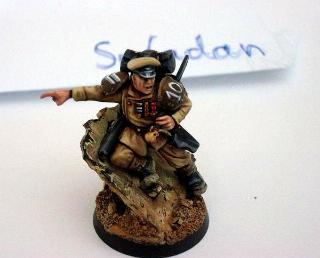Finishing Touches
Written by Scarab

Imperial Commander on scenic base, by Captain Engelhardt
Why is basing important?
Basing is often considered an afterthought, but a well finished base can greatly improve the appearance of an otherwise ordinary model, and a messy base can spoil a well painted one. It is therefore worth spending the time to make your bases look attractive, either by just finishing them neatly and uniformly, or by adding additional texture and detail. I have even experimented with sculpting and casting my own bases for a truly unique look.
What is a scenic base?
A scenic base is a base which has been treated with something more than just flock. It might just have some extra groundwork, or it might be quite elaborate, and include a piece of terrain or other models (such as dead bodies). Large models like dreadnoughts have large bases, and provide a lot of scope for adding scenery. The clear plastic flying bases are often left untouched, but they really look better with some scenery - consider treating the bottom of you flying stands like the rest of the bases in your army.
What are some ways of making scenic bases?
Scenic bases are all about texture to what is otherwise a rather bland part of the model. You don't want something too elaborate, or it will detract from the model itself. Make the base before you do any priming. Use modeling putty, and build up the groundwork, either by sculpting some sort of flagstones, or just natural rock (easily done by bashing the putty with a small rock). It's easiest to do this before the miniature is attached - press it into the putty while it's still wet. Then add some small stones or smashed brick, and some fine flock, for extra texture - attach these with white glue (PVA) or superglue. You might also add some small extras, like a skull, a discarded helmet or a weapon. Then proceed to the painting stage. Note that it's usually easier to paint the base before the rest of the model, although this is a matter of personal taste.
How do I use flock?
Paint watered down white glue onto the area to receive the flock. Alternatively, you can use paint, applied fairly thickly. Sprinkle the flock or grass on or dip the base into a box containing the flock. Consider painting the flock so as not to have some parts of the model unpainted, spoiling the look of the model. If you do paint it, start by painting the flock black (this will also help hold it in place), then drybrush it with green or brown, depending on whether it's intended to be grass or dirt.
How do I use static grass?
First, finish the base. It will need to have been flocked (preferably with sand) or otherwise modeled, and painted. You can apply static grass with PVA glue, but superglue is better. Put a small amount of superglue on the desired spot, then get a clump of static grass (it's best to use tweezers). Push it down into the glue - use much more than you need. Turn the model upside down, and tap off the excess static grass back into the container you got it from. Then, blow the grass to make it stand up. Be very careful with this stuff, as it's not good for you if you breathe it in. When it's dry, it's a good idea to paint it with camo green or rotting flesh, to make it look less bright.
How do I apply decals?
Games Workshops decals were once fairly awful, but the more recent ones are much better, and are worth using because they add a lot of interest to a model. Decals do not usually adhere well to a matte surface. They need a smooth, glossy surface. The way to achieve this is to paint the areas that will receive decals with gloss varnish. Wait for it to dry, then apply the decals, using a decal softener if possible. Decal softeners are produced by Microsol, and are found in specialist hobby shops. Make sure you gently press the decal into place, so there's no air trapped underneath. It's important to varnish the model after the decals have set, both to remove the gloss effect, and to ensure that they won't become brittle and flake off.
Should I varnish my finished models?
Absolutely. Varnish will protect the paint from dust and humidity and (to some extent) from wear and tear. Unfortunately, it won't protect your models from being dropped or otherwise mistreated! Ideally, you should give your models a coat of gloss varnish and then a coat of matt varnish, because gloss varnish tends to be more durable, but few people do this. Remember too that varnish will tend to darken the colours, and matt varnish also tends to have a dulling effect, so the more varnish you add the darker the overall finish.
Games Workshop produces a matte varnish, but it's not universally popular because it's rather temperamental. Testors Dullcote is better, if you can find it. Whichever brand you use, spray the whole model with a couple of thin coats, because if it's applied too thickly it will dry glossy.